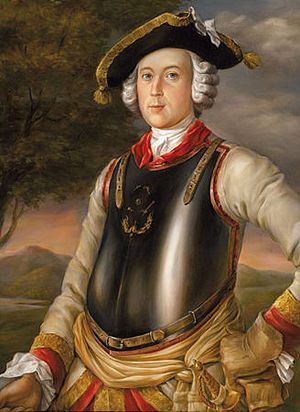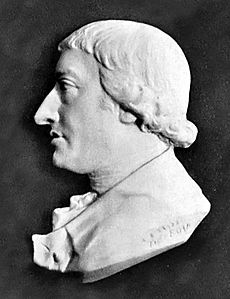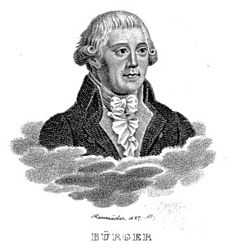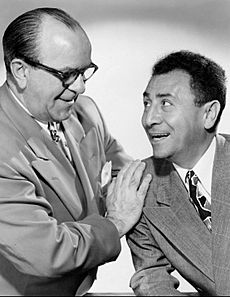Baron Munchausen facts for kids
Quick facts for kids Baron Munchausen |
|
|---|---|
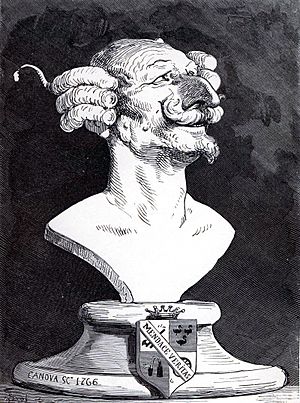
Gustave Doré's portrait of Baron Munchausen
|
|
| First appearance | Baron Munchausen's Narrative of his Marvellous Travels and Campaigns in Russia (1785) |
| Created by | Rudolf Erich Raspe |
| Portrayed by |
|
| Voiced by |
|
| Based on | Hieronymus Karl Friedrich von Münchhausen (1720–1797) |
| Information | |
| Nickname(s) | Lügenbaron ("Baron of Lies") |
| Title | Baron |
| Nationality | German |
Baron Munchausen is a famous fictional German nobleman. He was created by the German writer Rudolf Erich Raspe in his 1785 book Baron Munchausen's Narrative of his Marvellous Travels and Campaigns in Russia. The character is loosely based on a real person named Hieronymus Karl Friedrich, Freiherr von Münchhausen.
The real-life Münchhausen was born in Bodenwerder, Hanover, Germany. He fought for the Russian Empire in a war between 1735 and 1739. After he retired in 1760, he became known among his friends for telling amazing, exaggerated stories. These stories were based on his time in the military.
Rudolf Raspe heard some of these tales. He then wrote them down and published them anonymously in a book in 1785. The book quickly became popular and was translated into many languages. The real Baron Münchhausen was very upset that a fictional character with his name was being used. He even threatened to sue the publisher. Raspe never admitted he wrote the book during his lifetime.
The fictional Baron's adventures are told by himself. They focus on his impossible feats as a soldier, traveler, and sportsman. For example, he rides a cannonball, fights a giant crocodile, and even travels to the Moon. The stories are meant to be funny. They highlight how silly and unbelievable the Baron's claims are. They also make fun of society in a subtle way. The Baron Munchausen stories are still popular in Europe. The character has inspired many memorials, museums, and even medical terms.
Contents
The Real Baron: Hieronymus von Münchhausen
Hieronymus Karl Friedrich von Münchhausen was born on May 11, 1720, in Bodenwerder, Germany. He came from an aristocratic family. When he was young, Münchhausen worked as a page for a duke. He followed the duke to the Russian Empire during the Russo-Turkish War.
In 1739, he joined the Imperial Russian Army as a cavalry officer. He was stationed in Riga and fought in two battles against the Ottoman Empire. In 1744, he married Jacobine von Dunten. He was promoted to the rank of rotmistr (a cavalry captain) in 1750.
In 1760, Münchhausen retired from the military. He went back to live on his family's land in Bodenwerder. During this time, he became famous for telling amazing stories. He would host dinners for local noblemen and share funny, exaggerated tales about his military adventures in Russia. Many traveling noblemen would visit him just to hear his stories.
People who knew him said he told his stories in a confident, military way. He made them sound like normal events, even though they were wild. People didn't think he was a liar. Instead, they saw him as an honest man who used unbelievable stories to make fun of people who believed everything.
How the Fictional Baron Was Created
The fictional Baron Munchausen was created by Rudolf Erich Raspe. Raspe was a German writer and scientist. He likely met the real Hieronymus von Münchhausen while studying at the University of Göttingen. He might have even been invited to dinner at the Baron's home.
Raspe later had to flee Germany and settle in England because of some legal troubles. While in England, he wrote down a collection of stories inspired by Münchhausen's tales. He first published them in German magazines. These stories were only identified as "M-h-s-n Stories," keeping the real Baron's name partly hidden. Raspe did not put his own name on them either.
In 1785, Raspe turned these stories into a short English book. This time, he called the narrator "Baron Munchausen." He still didn't put his own name on the book. This English version was the first time Munchausen appeared as a full literary character.
The book became very popular. Other publishers and writers started adding more stories and changing Raspe's original text. This meant that many later versions of the book were different from what Raspe first wrote. The book was translated into French, Spanish, and German very quickly.
The first German translation was done by the poet Gottfried August Bürger. His version was even more popular in Germany than the English one. Bürger added new material, including a story based on a German legend.
Raspe never publicly said he wrote the book. He was probably afraid the real Baron von Münchhausen would sue him. For a long time, people thought Bürger wrote the book. It wasn't until 1824 that Raspe's authorship was finally proven.
The real Baron von Münchhausen was very angry about the book. He felt it hurt his reputation as a nobleman. He became a recluse and stopped telling his stories. He even tried to take legal action against Bürger and the publisher, but he was not successful.
The Fictional Character's Amazing Adventures
The fictional Baron Munchausen is a braggart soldier. He is known for his comically exaggerated stories about his own adventures. All the stories in Raspe's book are told by the Baron himself. A note in the book says that "the Baron is supposed to relate these extraordinary Adventures over his Bottle, when surrounded by his Friends."
The Baron's stories make him seem like a superhuman figure. He often gets out of impossible situations or causes funny trouble. Some of his most famous stories include:
- Riding a cannonball.
- Traveling to the Moon.
- Being swallowed by a giant fish in the Mediterranean Sea.
- Saving himself from drowning by pulling himself up by his own hair.
- Fighting a forty-foot crocodile.
- Using a wolf to pull his sleigh.
- Fixing his horse with laurel tree branches after it was accidentally cut in half.
In his stories, the Baron acts calm and logical. He describes unbelievable events with simple facts. He only shows mild surprise at absurd things. He even doubts unlikely events he hasn't seen himself. This creates an ironic tone, making the reader question his claims. There's also a subtle social satire hidden in the stories.
The Baron is also shown as a brave hunter and fighter. He is a polite gentleman who enjoys knowledge. He likes to be very precise about details in his stories. He also loves good food and drink. Many of the references in Raspe's original text are to real historical events from the real Baron's military career.
Because the Baron's feats are clearly impossible, they are easily recognized as fiction. This suggests the Baron is a liar. In Raspe's first book, he just tells his stories without comment. But in later versions, he insists he is telling the truth. No matter how inconsistent his stories become, the Baron seems to believe every word. He usually doesn't care if others don't believe him.
- Illustrations for the stories
Many artists have illustrated the Baron's stories. Early pictures showed him as slim and young. Later, an anonymous artist in 1792 drew him as an old soldier with a face marked by his adventures. This image became the standard for many years. Gustave Doré's illustrations in 1862 kept the sharp nose and twirled mustache. But he made the Baron look healthier and friendlier. Doré's version became the most famous visual representation of the character.
The real Baron and the fictional Baron are connected, but they are also different. The fictional Baron is so separate that some people say the real person's identity doesn't matter. For example, Richard Asher named Munchausen syndrome (a medical condition) after the fictional character, not the real person. However, the real Münchhausen is still called the Lügenbaron ("Baron of Lies") in German. As one researcher said, "These two barons are the same and they are not the same."
Baron Munchausen in Pop Culture
The fictional Baron has appeared in many other books, plays, movies, and radio shows.
Books and Games
Many expanded versions of Raspe's book have been published. The Baron has also appeared as a character in other novels. For example, John Kendrick Bangs wrote new Munchausen stories in his 1901 book Mr. Munchausen. Hugo Gernsback even put the Baron in a science fiction setting in his novel Baron Münchhausen's New Scientific Adventures.
Philosophers have also used the Baron's stories. Friedrich Nietzsche and Ludwig Wittgenstein both referenced the story where the Baron pulls himself out of a swamp by his own hair. They used it as a metaphor for trying to achieve impossible things by oneself.
In 1998, a game designer named James Wallis created a storytelling game called The Extraordinary Adventures of Baron Munchausen. In this game, players make up their own Munchausen-like stories.
Stage and Audio
The Baron Munchausen stories have been adapted for the stage many times. There were pantomimes (a type of musical play) in London in 1795 and 1818. Playwrights like Herbert Eulenberg and Walter Hasenclever also wrote plays about the Baron. A Czech musical about the Baron, Baron Prášil, opened in Prague in 2010.
In 1932, the comedian Jack Pearl played Baron Munchausen in a popular radio comedy show. Pearl's Baron would tell his wild stories in a German accent. His co-star, Cliff Hall, played Charlie, who would express disbelief. The Baron's famous line was: "Vass you dere, Sharlie?" This line became a very popular catchphrase.
In 1972, the actor Peter Ustinov voiced the Baron for a recording of some of the stories. His portrayal showed the Baron's boastful personality.
Film and Animation
The early French filmmaker Georges Méliès made a silent film called Baron Munchausen's Dream in 1911. He was a big fan of the stories. Méliès's famous 1902 film A Trip to the Moon might have been inspired by the Baron's journey to the moon.
Many animated versions of the stories have been made. Émile Cohl made a cutout animation in 1913. Other animated films were produced in Germany and the United States. In the Soviet Union, there were several animated versions, including a stop-motion animation in 1967 and a series of short films in 1973 and 1974.
In 1943, a big-budget German color film called Münchhausen was made. Hans Albers played the Baron as a cheerful but somewhat mysterious character. In 1961, the Czech film The Fabulous Baron Munchausen combined animation with live actors. It was based on Doré's famous illustrations.
In 1979, Oleg Yankovsky played the Baron in the Russian television film The Very Same Munchhausen. This film was a funny commentary on censorship. It showed the Baron trying to prove his adventures were true in a world that didn't believe him.
In 1988, Terry Gilliam directed a big Hollywood film called The Adventures of Baron Munchausen. John Neville played the Baron. His Baron seemed sensible, as if he had spent his whole life getting used to incredible things.
More recently, in 2012, a German television film called Baron on the Cannonball starred Jan Josef Liefers as the Baron.
Baron Munchausen's Lasting Impact
Memorials and Museums
In 2004, a fan club called Munchausen's Grandchildren was started in Kaliningrad, Russia. They tried to find "historical proofs" of the fictional Baron's travels through the city.
Bodenwerder, the real Baron's hometown, has a Munchausen monument in front of its Town Hall. It also has a Munchausen museum with many illustrated editions of the stories. Another Munchausen Museum exists in Duntes Muiža, Latvia. This was the home of the real Baron's first wife. The couple lived there for six years. In 2005, the National Bank of Latvia even made a special silver coin to celebrate the real Baron's 285th birthday.
Names and Concepts
In 1951, a British doctor named Richard Asher described a medical condition where patients lie about being sick. He called it "Munchausen's syndrome." He said that like the Baron, these patients often traveled widely and told dramatic, untrue stories. This condition is now usually called Munchausen syndrome. Two other related terms are Munchausen syndrome by proxy (when a caretaker fakes illness for someone else) and Munchausen by Internet (when illness is faked online).
In philosophy, the term Münchhausen trilemma was created in 1968. It describes a problem in proving ideas. It's named after the Baron's story of pulling himself out of a swamp by his hair. This same story also inspired the mathematical term Munchausen number in 2009. These are numbers whose digits, when raised to their own powers, add up to the number itself.
A category of folklore stories, ATU1889, is called "Münchhausen Tales" because of these stories. In 1994, a main belt asteroid was named 14014 Münchhausen to honor both the real and fictional Baron.
|
See also
 In Spanish: Barón de Münchhausen para niños
In Spanish: Barón de Münchhausen para niños


